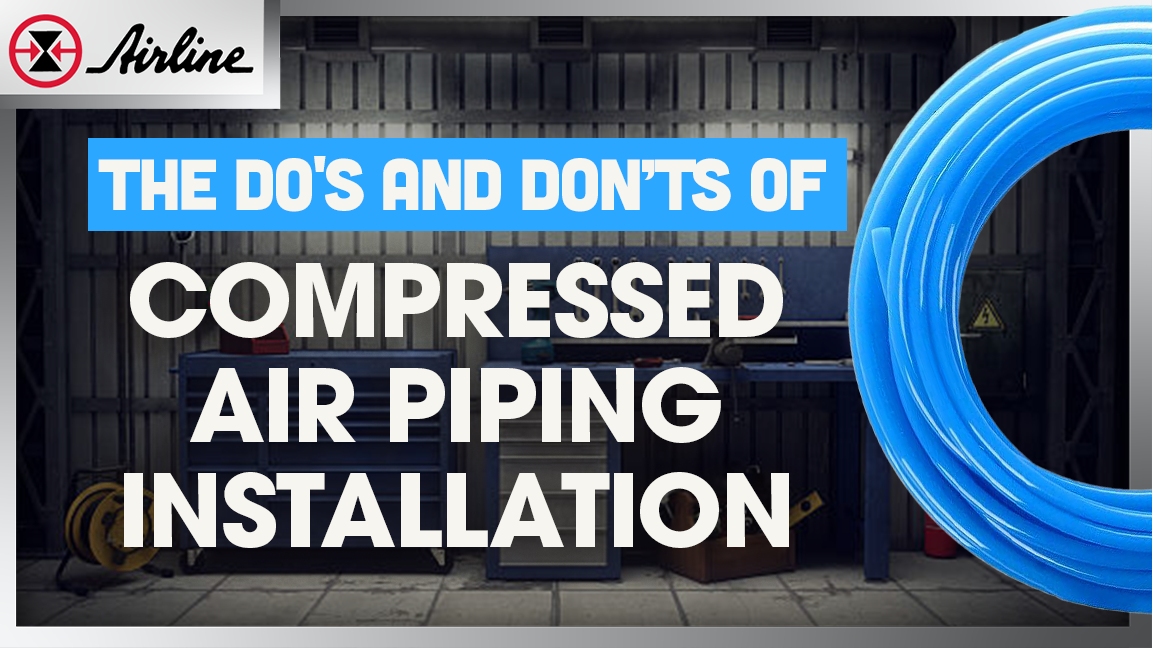Compressed air is the lifeblood of manufacturing and automation, playing a vital importance just like the human circulatory system. Its role goes beyond mere functionality; it becomes the pulse of productivity, ensuring a seamless flow of power, and pumping the heart of industrial processes. Although understanding the essentials of compressed air piping installation can be challenging, it is crucial for establishing or improving systems. Join me as I review the dos and don'ts of air piping installation, exploring best practices and potential pitfalls.
Skip to a Section
New Plant Air Systems Guide: | The Do's of Compressed Air Piping Installation |
The Don'ts of Compressed Air Piping Installation | Summary | Resources
New Plant Air Systems Guide:
My hope is this knowledge empowers pneumatics engineers to make well-informed decisions for optimal system performance.
The Do's of Compressed Air Piping Installation ✔️
Plan Your System Carefully
Thorough planning is the bedrock of a successful compressed air system. Consider air quality, flow rates, pressure levels, and facility layout to design a system tailored to your needs. Remember, planning for equipment requirements is imperative to avoid undersizing and overloading your compressor.
Use the Right Materials
![]()
Select high-quality materials suitable for compressed air systems, such as aluminum, for its cost-effectiveness and easy installation. Go the extra step and ensure materials are rated for pressure and temperature conditions. Not sure where to start? Check out the EPL from Ingersol Rand.
Properly Size Your Pipes
Size your pipes correctly based on required flow rates and pressure drops. Getting the correct sizing helps avoid undersized pipes leading to reduced performance or oversized pipes causing inefficiencies.
Install Isolation Valves
Incorporate isolation valves at critical points for easy maintenance, allowing specific sections to be shut off without disrupting the entire system.
What are isolation valves? Watch our video here to learn the basics of isolation valves and their three types: pinch valves, diaphragm valves, and rocker valves.
Use Suitable Pipe Supports
Install sturdy supports to prevent sagging, ensuring a stable system that minimizes stress on pipes and connections.
Follow the Manufacturer's Guidelines
![]()
Adhere to the manufacturer's guidelines for fittings, connectors, and installation techniques to guarantee safe and efficient operation.
Consider Condensate Management
Ensure effective condensate management by implementing a comprehensive system, eliminating moisture, safeguarding against corrosion, and prolonging the lifespan of your equipment. Install air quality monitoring equipment along extended pipe runs and in areas where temperature fluctuations occur. Additionally, incorporate drip legs to redirect moisture to a designated drain point, further enhancing the efficiency and maintenance of your compressed air system.
Perform Regular Inspections
![]()
Be proactive and schedule routine inspections to detect leaks and wear early, preventing costly repairs and minimizing hidden costs like increased electric bills due to leaks.
The Don'ts of Compressed Air Piping Installation ❌
Don't Use PVC Pipe
Avoid PVC pipes for compressed air systems, as they can become brittle over time, posing safety and health risks. Moreover, IOSHA has banned the use of PVC for compressed air systems (unless buried or encased). Learn more from this OSHA-published flyer here. Or check out the video below.
Don't Ignore Pressure Drop Considerations
![]()
Neglecting pressure drop calculations is a mistake; doing so can reduce tool performance and can exert unnecessary energy waste.
Don't Use Thread Sealant on All Fittings
Apply thread sealant sparingly to prevent any obstruction in the piping system. Be careful not to cover the end of the threads, as this can lead to sealant entering the flow path. If you do use sealant, make sure to leave the first thread uncovered to avoid any sealant falling into the flow path.
Don't Over-Tighten Fittings
Over-tightening fittings should be avoided as it can lead to thread damage and potential leaks. It is important to follow the torque specifications recommended by the manufacturer for optimal application.
Label Components
![]() Ensure easy identification and operation of system components by utilizing a blue arrow for air piping, an industry standard that facilitates navigation in plant ceilings.
Ensure easy identification and operation of system components by utilizing a blue arrow for air piping, an industry standard that facilitates navigation in plant ceilings.
Don't Skip Training
Ensure all personnel involved in installing and maintaining your compressed air system undergo comprehensive and specialized training. This training should encompass a thorough understanding of the system's intricacies, troubleshooting techniques, and safety protocols. Well-trained personnel are equipped to swiftly identify and address any issues that may arise, promoting both operational efficiency and workplace safety. Check out our past and present training events here for free, in-depth training opportunities.
Don't Neglect Proper Pipe Alignment
![]()
Ensure proper pipe alignment and support to prevent leaks and system inefficiencies. Maintain a ¼" per 10' length drop for effective moisture drainage.
Don't Use Galvanized Pipe Without Proper Precautions
If using galvanized pipe, take precautions to prevent zinc contamination, which can damage downstream equipment.
Summary
By adhering to these do's and don'ts of compressed air piping installation, you pave the way for a reliable, efficient, and safe compressed air system. A well-installed system enhances productivity and contributes to cost savings and prolonged equipment longevity.
Still not convinced you've mastered the art of compressed air piping? No worries; our experts are here to help. Contact us; we will help you meet operational needs and eliminate maintenance headaches.








Leave Comment